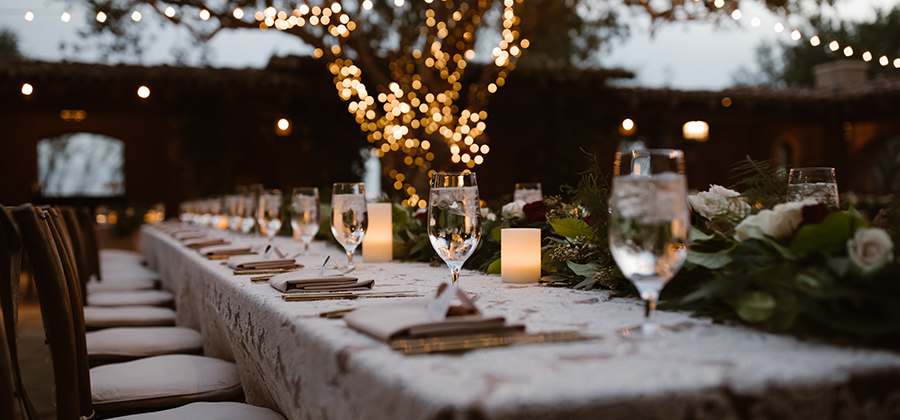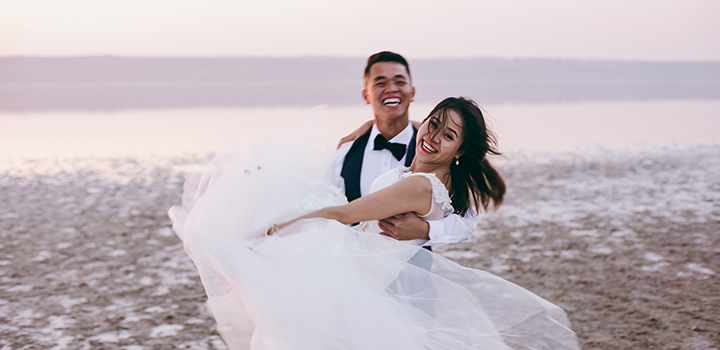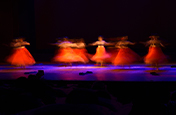Wedding photography tips on wedding shot lists, equipment recommendations, and more.
From the first look to the last dance, wedding photographers need a plan for a couple’s big day. Get insight on preparing for the formal photoshoot and capturing candids.

Wedding photos are only part of the equation.
They call it “The Big Day” for a reason. Weddings require a massive amount of planning. And those logistics don’t just apply to the ceremony, the cake, and the conga line.
“I respect the hell out of wedding photographers,” says editorial and portrait photographer Grace Rivera. She doesn’t normally do weddings, but shooting a recent destination wedding gave her a new perspective on the genre. “It’s really tough. You have to embody fashion, documentary, event, portrait — every field of photography — into one day where you have seven hours to create a huge body of work.”
With so much to juggle, from lengthy shot lists and multiple locations to wrangling a large wedding party, and a finite amount of time to get your photos, it’s a tall order for even the best wedding photographers. Putting together a strategy is essential, and that preparation can save you when the best-laid plans fall apart.

How to prepare for wedding photography.
Schedule and shot list
With just one day to get it all done, you don’t want to miss a thing. Meeting with the wedding couple in advance to go over the schedule and develop a shot list means you won’t have disappointed clients.
“I give couples a timeline planning worksheet,” wedding photographer and author Khara Plicanic says. This not only lets her get the day’s schedule down on paper, but it also provides a way to address potentially unrealistic timing.
Helping a couple realize they won’t go straight from the wedding ceremony to the reception when they have to greet 300 people in the receiving line will ensure you’re scheduling the proper amount of time to capture the shots that are most important to the bride and groom, or brides and grooms.

Here are key wedding shot list considerations to cover with the couple:
1. Do either or both people want photos of them getting ready? If so, when does that process begin?
2. Will photos of the wedding party and family be taken before or after the ceremony? What members of the family should be present for these photos and when do they need to show up? Will members of the wedding party’s dates be in these photos?
3. If the first look between the couple takes place before the ceremony, it needs to happen before any other photos. Make sure to leave enough time for this important emotional moment.
4. Get a basic rundown of the ceremony so you can be ready to capture special moments during this packed 30- to 60-minute part of the day.
5. What’s the schedule for the reception? Are events like a first dance, father-of-the-bride dance, and cake cutting happening? Get the timing on these so you’re not changing camera batteries when the bouquet’s being thrown.
6. When are you going to eat? It’s important to find holes in the schedule that allow you time for food, water, and trips to the restroom.
Lighting
Knowing the day’s schedule will help you understand what type of lighting you’ll be working with. While golden-hour lighting (flattering, soft natural light that happens typically an hour after sunrise or before sunset) might be ideal for wedding portraits, many weddings take place during the middle of the day when the lighting is harsher.
“With the sun directly overhead, you end up with deep shadows under people’s eyes,” wedding photographer Anna Goellner explains.“ I always look for shade this time of day, be it from trees or buildings — whatever you can find to provide more even lighting. If no shade is around, try to put the sun behind your clients for a softer look.”
Show up before guests arrive to scout lighting around the venue. It can save you some stress later on.

If the festivities move into the evening, it might be necessary to use a camera flash. A technique called “dragging the shutter” can be perfect for capturing dimly lit wedding scenes without losing background details, photographer Kilen Murphy says.
By slowing down the shutter speed of your camera and raising the ISO (which controls the camera’s sensitivity to light), a flash can illuminate the foreground subject while still taking in the background light — perfect for capturing guests dancing at the reception without losing details of the venue around them. Even without flash, Goellner says that a higher ISO and lower shutter speed, with some experimentation, can be great for low-light reception photography.
Equipment
Regardless of location, once the day begins, there’s no popping out to grab another lens. So come prepared. Beyond a flash, you’ll want lenses that can capture a variety of shots. Consider the types of shots you’ll want to get to build out your wedding photography equipment checklist. Plicanic, for example, uses a versatile 50mm lens for capturing live photojournalistic moments, a 16–35mm lens for wide shots necessitated by large wedding groups, and a 70–200mm lens to capture intimate moments from a distance.
Prepare yourself for the elements as well. If you’re in sunny southern California, dress appropriately for the heat. But if you’re in Chicago in the winter, bundle up and prepare for the snow. You don’t want to be distracted during the shoot, so make sure you’re in professional, comfortable gear.

Another set of eyes can be an invaluable resource, as well.
“I had two cameras on me, two cameras on my second shooter, and a variety of lenses,” Rivera recalls. “You want to make sure you have a long lens to catch faraway moments and a wider lens so you can switch between the two rapidly — especially during the ceremony when you only have 30 minutes to get everything that you need.”
On the big day, expect the unexpected.
The bride and groom probably have a plan for rain on their wedding day, and as the photographer at the event, you too need to be ready for moments no shot list can possibly foresee. While the couple is tying the knot, being observant and nimble can help you capture truly unique, memorable moments the wedding couple will never otherwise see.

“I try to think, ‘What would be special and meaningful?’” Plicanic says. “I want them to gasp when they look at their pictures. And often, what I hear is, ‘I had no idea this was happening! How did you get that?’”
No one can witness everything that happens at their own wedding and, often, a keen-eyed photographer chronicling candid moments can make a couple feel like they hired someone who went above and beyond.
“When I delivered the images, there were so many moments that weren’t on the list,” Rivera says. “But the bride was obsessed with them.”
How to capture these moments? Experience builds skill, but really, it comes down to looking for narratives within the day that tell stories the couple, with a thousand things to do, will surely miss in the moment.
“I watch out for people having a really good conversation and laughing,” Plicanic says. “It captures the experience from the guests’ perspective, too.”
And don’t forget to embrace the controlled chaos. Sometimes that frenetic wedding energy fuels great photos.
“Everything is so fast-paced throughout the day. Sometimes you don’t necessarily have time to compose the image perfectly,” wedding photographer Naba Zabih says. “But those photos can still be very impactful, sometimes because of the fact that it’s not totally following the rules.”
The costs and considerations of wedding photography.
Typically, a couple hires a photographer because they like the photographer’s existing work, but managing expectations is still important.
“They’re mostly looking to you to do your thing,” Plicanic says. “It’s more about educating them about what you do, how you do it, and how they can help you do your job.”
That education can establish realistic expectations. “You need to help them understand that a lot of reference images they pull are editorial wedding shoots where one shot took eight hours to produce,” Rivera says.
You may find yourself in a situation where a couple asks for something beyond what you’ve done in the past. To determine if that’s a request you can accommodate, break down the money and time considerations. This is a process that every photographer looking to shoot weddings professionally should go through.

1. Operational costs: From equipment costs to tax deductions, understanding what it costs to be a business will help you understand what you need to charge for your time. Don’t forget insurance, software, web hosting, and data storage in these calculations, including what you might need to pay an accountant. Will you need to hire a second photographer to help capture a larger wedding? Factor it in. Travel to and from the venue can add up, as well.
2. Delivery costs: If you’re offering physical products like photo albums or printed images, factor in those costs to your pricing.
3. Time costs: How much time are you spending at the wedding? What about consultation and preparation prior to the event? Make sure to also add in time spent processing and editing photos, plus time spent getting the final product or package to your client.
4. Opportunity costs: When considering your income over the course of a year, remember that wedding photography is a seasonal industry with most hiring opportunities hitting between late spring and early fall. You can only be in one place at a time — you can’t shoot two weddings on a single day — and most weddings fall on Saturdays, so booking a weekend means you’ll have to refuse other work on that date. Keep this in mind when building the pricing of your offerings. You may have to turn down a couple looking at a weekend you’ve already booked, so making sure you’re charging the right amount to meet your financial needs is incredibly important.
5. The cost of your expertise: Though it takes time to build the knowledge and skill of an experienced wedding photographer, seasoned pros can be invaluable in helping couples navigate day-of unknowns like bad weather, schedule shifts, challenging lighting, and difficult guests. When the question of, “Why does this cost X amount?” comes up, experienced photographers can explain it’s about their ability to handle these challenges with confidence during a hectic event. As your confidence and experience build, make sure to adjust the rates of your offerings accordingly.

There’s no industry standard for these costs; the size and type of wedding, as well as regional cost differences, make any universal pricing impossible. How wedding photographers handle these business decisions will be varied, but understanding your financial needs and what you need to shoot successful photography during the event should guide this process.
When you’ve got the business and pricing set up, you can be confident with your clients. And when you’re confident about these details, you can build confidence with them that you’re the right person to document their special day.
Contributors
Do more with Adobe Photoshop Lightroom.
Edit photos easily with Lightroom presets, Super Resolution, easily share photos from any device, and access your projects anywhere with cloud photo storage management.
You might also be interested in…
Discover ways to select the ideal focal length for any and every photo.
Creating great portrait photography.
Take a step closer to perfect portraits with tips and advice from professional photographers.
How to add bokeh backgrounds to your photographs.
Learn more about the beautiful blur effect that can give your photos a striking look.
Discover how adjusting shutter speed can help you capture clean shots or motion-filled moments.



